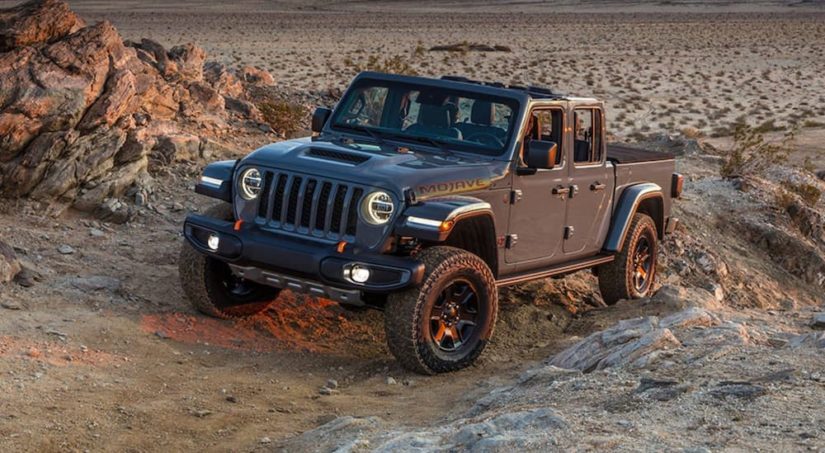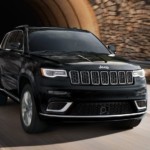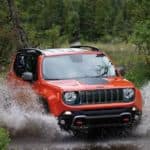You’re ready to answer the call of the wild, and that’s led to your search for an epic adventurer. So naturally, you need a truck that will meet the demands of your workweek and handle those DIY projects around the house, but you also want to ensure it’s capable of getting a little (or a lot) of mud on the tires. That’s led you down a rabbit hole, comparing best-selling rivals like the 2022 Jeep Gladiator vs the 2022 Toyota Tacoma.
Which is the better on and off-road warrior? The Tacoma, affectionately known as the “Taco” among off-roaders, is a staple on the trail and is praised for its versatility. Its midsize platform makes it agile and easy to maneuver in tight areas, while a vast array of aftermarket parts gives drivers plenty of options for further customization. But is this enough to beat the Jeep legacy? Not hardly.
The 2022 Tacoma might be a crowd favorite, but the 2022 Jeep Gladiator easily overshadows everyone’s love of tacos, at least in the Toyota sense. The Gladiator recently returned to the Jeep lineup, blending on and off-road capability to give drivers the best of both worlds. Here’s a closer look at how the Gladiator outshines the Tacoma and why you’ll want to make joining the Jeep Wave family a top priority on your to-do list before you hit the trail.
#1: Power
Toyota and Jeep give you a choice between two powertrains that deliver a wide range of power. However, it’s hard to beat Jeep’s award-winning powerplants. For example, the Tacoma’s standard 2.7L four-cylinder engine ekes out 159 horsepower and 180 lb-ft of torque, a stark contrast to the Gladiator’s award-winning 3.6L Pentastar V6 engine that delivers 285 horsepower and 260 lb-ft of torque for exceptional handling at any speed.
The Tacoma’s available 3.5L V6 engine pushes the truck’s output to 278 horsepower and 265 lb-ft of torque, but that’s the peak level of the Toyota’s performance. As expected, the Gladiator does a better job of answering this need with its turbocharged 3.0L EcoDiesel V6 engine that churns out 260 horsepower and 442 lb-ft of torque for remarkable low-end power and efficiency. For comparison, the Tacoma’s more efficient 2.7L four-cylinder averages 20 MPG in the city and 23 MPG on the highway, while the Gladiator’s diesel powerplant averages 22 MPG in the city and 28 MPG on the highway.
#2: Towing and Payload
The Tacoma and Gladiator are more than capable workhorses, with their multi-engine lineups guaranteeing their ability to tow modest-size loads with ease. Even so, the Gladiator’s powertrains offer greater capability and give the Jeep another advantage over its rival. For example, the Gladiator can tow anywhere from 6,500 to 7,650 pounds maximum and support up to a 1,700-pound payload. In contrast, the Tacoma’s top towing capacity ranges from 3,500 to 6,800 pounds, with a max payload between 1,525 and 1,685 pounds. This can mean the difference between hauling the family camper and the necessary gear to the lake for the weekend or leaving extra amenities behind for the sake of safety and performance.
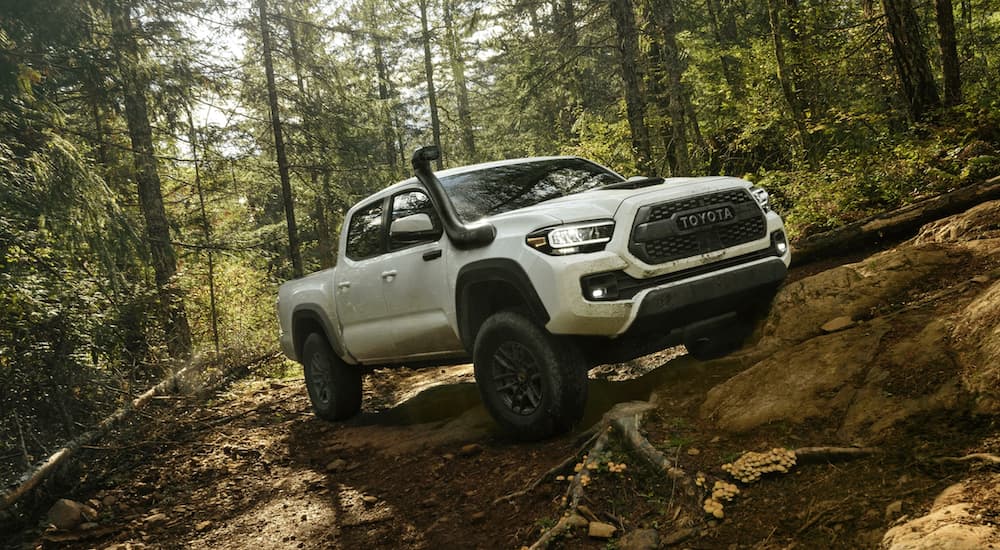
#3: Four-Wheel Drive Capability
Jeep’s reputation for its four-wheel drive capability is legendary and can be traced back to the dawn of World War II when it delivered a light reconnaissance vehicle to the United States Army. Today, Jeep’s reputation continues with models like the Gladiator that offer three renowned four-wheel drive systems: Command-Trac, Selec-Trac, and Rock-Trac. This vast range of four-wheel drive capability gives the Gladiator another advantage over the Tundra with its standard four-wheel drive system.
The Gladiator‘s Command-Trac is a part-time four-wheel drive system that outfits the truck with four operating modes: 2WD High, 4WD High, Neutral, and 4WD Low. The Selec-Trac system is a full-time four-wheel drive system that adds Auto mode to the operating system, maximizing the Gladiator’s performance in everyday on-road and off-road conditions. Finally, the Gladiator Rubicon comes standard with the Rock-Trac system, which is available as a full-time system that lets you set it and forget it since it constantly sends power to the front and rear wheels to maximize traction and handling.
These legendary four-wheel drive systems are also an integral part of the Gladiator’s Trail Rated and first-ever Desert-Rated badges. Jeep pushes models like the Gladiator to their limits, putting the Gladiator to the test to determine its traction, water fording, maneuverability, articulation, and ground clearance in the harshest conditions. These badges reflect the Gladiator’s off-road prowess and give the Jeep another significant advantage over the badge-less Tacoma.
#4: Off-Road Components
Since the Gladiator and Tacoma, specifically trims like the Rubicon and TRD Pro, are destined for the trail, it’s no surprise that the trucks are equipped with off-road components that heighten their abilities off the pavement. Moreover, these components somewhat level the playing field, giving the Gladiator and Tacoma a substantial advantage over less capable models. For example, the trucks both come with electronic locking differentials, Fox shocks, and skid plates. However, the Gladiator distinguishes itself with heavy-duty solid Dana test 44 front and rear axles with extra-thick tubes for unmatched rigidity, durability, and strength.
Despite sharing many similar components, how these components accentuate the trucks’ capabilities directly impacts their off-road abilities in terms of measurements, something off-roaders are quick to ask when shopping for a rig. For example, the Tacoma TRD Pro’s suspension lift adds to its height and gives it a 9.4-inch ground clearance, which is nearly two inches shorter than the Gladiator’s clearance of 11.1 inches. Similarly, the Gladiator offers a better approach angle of 43.4 degrees than the Tacoma at 32 degrees. The Jeep is also capable of fording water up to 31.5 inches deep, making the Gladiator a swamp-savvy adventurer by every standard.
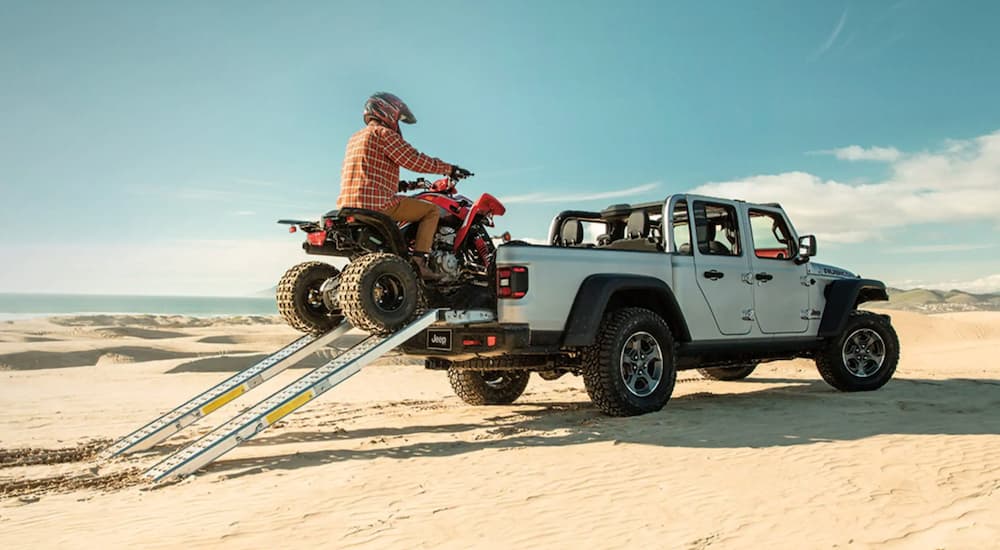
#5: Technology
Just as the Gladiator and Tacoma offer comparable off-road features, they’re also outfitted with similar technology designed to keep drivers connected and informed on the road and trail. For example, the Gladiator offers a TrailCam system that gives you a real-time view of the trail ahead from the center touchscreen display. The Tacoma’s Multi-Terrain Monitor is similar, allowing you to check your immediate surroundings. Beyond these cameras, the trucks also offer smartphone integration via Apple CarPlay or Android Auto. In addition, you’ll find the off-road rigs are equipped with Amazon Alexa, which allows you to stream your favorite music, listen to a podcast, respond to messages, make calls, and more with simple voice commands even when on the trail.
And the Winner Is
It’s hard to compete with a legend, and comparing the 2022 Jeep Gladiator with the 2022 Toyota Tacoma proves as much. The Gladiator is off-road ready straight from the factory, blending Jeep’s reputation for capability with the versatility of a traditional workhorse. Its award-winning powertrains and three legendary four-wheel drive systems guarantee you have all the power you need, whether cruising at highway speeds or pushing the Trail Rated or Desert Rated truck to its limits.
In contrast, the Toyota Tacoma lags behind its rival, ignoring the need for a diesel powerplant and limiting its four-wheel drive systems to a single option. Even so, the Tacoma is a favorite for many off-roaders because of its utilitarian design and host of aftermarket accessories that make it easy to customize. Fortunately, the Gladiator’s return gives Jeep fans another viable option that’s fully customizable and capable of answering every call of the wild. As a result, the Gladiator gains a remarkable lead on the trail, leaving tacos for Tuesday night dinners.
